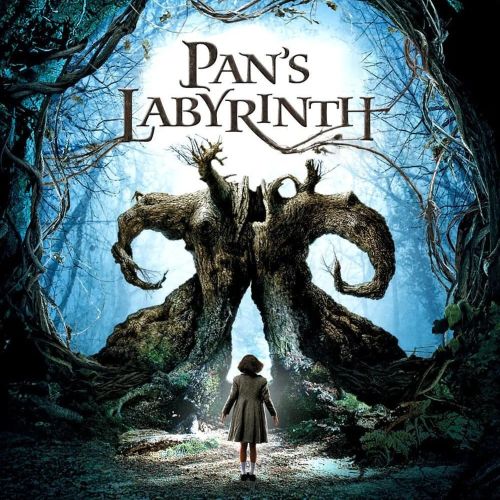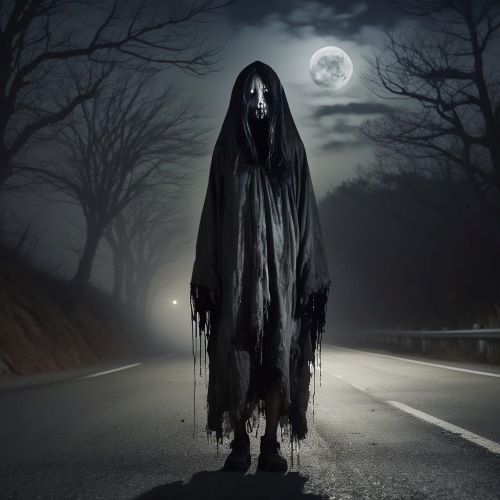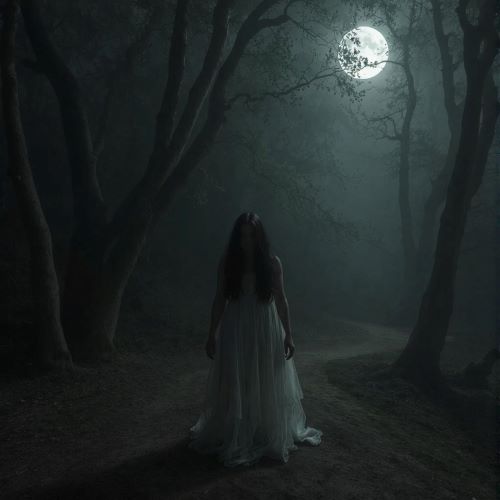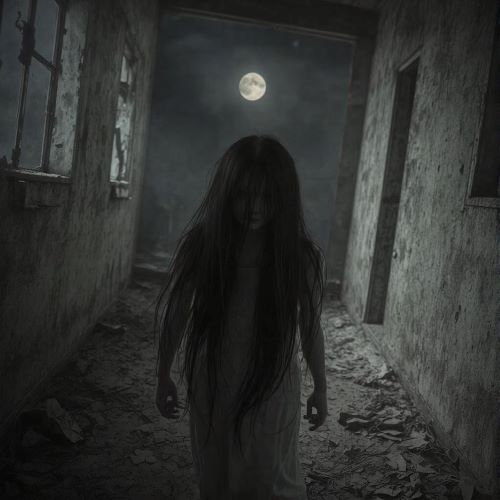Bloody Mary : The Woman in the Mirror
| Description | |
|---|---|
| Origin | England |
| Classification | Ghost |
| Demeanour | Evil |
| Habitat | Mirrors |
| Status | Still Invoked |

Introduction
Bloody Mary is a chilling legend about a ghostly figure that appears in a mirror when summoned by repeatedly chanting her name. Depending on the version of the story, she may be a spirit, witch, or phantom, with an unpredictable nature ranging from benign to malevolent. The ritual is often performed as a test of courage, especially in group settings.
Historically, a divination practice involved young women walking backward up a staircase in a dimly lit house while holding a candle and a mirror. They hoped to glimpse their future husband’s face but risked seeing a skull or the Grim Reaper instead—an omen of early death.
Modern variations of the ritual instruct participants to stand before a mirror in a dark room and call out Bloody Mary’s name, typically 13 times. Those who claim to have encountered her describe her as a corpse-like figure, a sinister witch, or a vengeful spirit, sometimes dripping with blood. Reports vary, with some saying she screams, curses, or even attacks by scratching, strangling, or stealing souls.
A staple of urban folklore, Bloody Mary’s tale continues to captivate and terrify. Often shared at sleepovers and around campfires, it remains one of the most enduring and eerie ghost stories in popular culture.
Physical Attributes
Bloody Mary’s appearance differs across various accounts, but she is consistently portrayed as a ghostly female figure. She is often described with pale skin, long, unkempt hair, and hollow, dark eyes. Some versions depict her in a tattered white gown, her face streaked with blood from an open wound. Others portray her as a demonic witch reaching out from the mirror.
In several tales, she is associated with a baby—either cradling one, searching for one, or reacting violently to claims of harm against it. Some who summon her provoke her by chanting phrases like, “I stole your baby” or “I killed your baby.” Her terrifying presence is said to evoke intense fear, with witnesses reporting fainting, screaming, or fleeing in terror upon seeing her reflection.
First Sighting/Reporting
The origins of the Bloody Mary legend remain uncertain, though researchers began formally tracing its roots in the 1970s. The first known published versions appeared in American children’s folklore anthologies in 1976, while folklorist Janet Langlois’s 1978 study suggested the story may have stemmed from a witch accused of practicing dark magic. The ritual itself, however, likely existed long before it was documented, with its modern form gaining popularity in the U.S. after World War II.
Some historians speculate that the legend is linked to Mary I of England, also called Mary Tudor, infamous for her persecution of Protestants. Her brutal reign earned her the nickname “Bloody Mary,” and over time, her name may have merged with supernatural folklore. Others suggest a connection to Mary Worth, a supposed New England witch rumored to have kidnapped children and dabbled in dark magic, her vengeful spirit now haunting mirrors. Though no single explanation fully accounts for the tale’s origins, it is likely an evolving mix of ghost stories, historical fears, and urban legends passed down through generations.
Other Names
The Bloody Mary legend has taken on many names across different regions and interpretations. Some of the most common variations include Hell Mary, Mary Worth, Bloody Bones, and Mary Whales. Other versions reference figures like Mary Worthington, Mary Johnson, and Black Agnes, reflecting the tale’s adaptability over time.
Despite these differing names, the essence of the legend remains unchanged—a spectral woman summoned through a ritual involving a mirror and the repeated chanting of her name. The widespread variety of names suggests that the story has been retold and reshaped by different cultures, each adding its own twist to the chilling myth.
Modus Operandi
The ritual to summon Bloody Mary follows a basic pattern, though details vary across versions. Most commonly, participants enter a dimly lit room—typically a bathroom—where they face a mirror and chant her name a set number of times, usually between three and thirteen. Some versions add extra elements, such as spinning in circles, splashing water, or using red candles. Midnight is often considered the ideal time for the ritual.
Depending on the legend, those who summon her may face dire consequences. Bloody Mary is said to appear in the mirror as a grotesque figure, sometimes covered in blood, and may scream, curse, or physically attack the summoner. Some tales describe violent outcomes, including scratches, blindness, or even death. Others suggest she can reveal the future, answering questions in an eerie and unsettling manner.
Psychologists suggest that prolonged gazing into a mirror in low light can lead to hallucinations, a phenomenon known as the “strange-face illusion.” Facial features may distort, disappear, or take on monstrous appearances due to a misfire in the brain’s facial-recognition system. Whether viewed as a supernatural encounter or a psychological trick, the Bloody Mary ritual continues to be a popular test of bravery, often performed at sleepovers and around campfires.
Pop Culture References
The Bloody Mary legend has left a lasting mark on pop culture, influencing a wide range of media, including films, television, books, and video games. In cinema, horror films have frequently drawn inspiration from the tale. Urban Legends: Bloody Mary (2005) depicts the vengeful spirit targeting descendants of those responsible for her death. Other films, such as Dead Mary (2007) and The Legend of Bloody Mary (2008), explore different takes on the terrifying entity. The Candyman franchise also shares thematic similarities, with a mirror-summoning ritual at its core.
Television has also embraced the myth, with shows like Supernatural featuring an episode where a ghostly Mary Worthington attacks those harboring deadly secrets. Charmed and Ghost Whisperer have also woven the legend into their supernatural narratives. Video games incorporate Bloody Mary in various ways. In The Wolf Among Us, she appears as a sinister Fable who can move through reflective surfaces. Mirror-related horror elements in Silent Hill 2 and The Sims 2: Nightlife also evoke the legend’s eerie presence.
Even music and literature have drawn from the myth. Lady Gaga referenced Bloody Mary in her Born This Way album, while horror novels and short stories have continued to expand on her chilling tale. These adaptations ensure that the legend remains an enduring part of modern folklore.
Current Status
The Bloody Mary legend remains a staple of urban folklore, continuing to captivate those drawn to the supernatural. The ritual is still a popular dare at sleepovers, campfires, and Halloween gatherings, where thrill-seekers test their courage by summoning the spectral figure in a mirror.
Scholars have analyzed the tale’s psychological and cultural significance, noting its role in exploring fears, testing bravery, and reinforcing social bonds. Despite being dismissed by skeptics as mere superstition, the legend endures because of its unsettling blend of the familiar and the uncanny—transforming an ordinary setting into a gateway for the unknown.
Rather than fading into obscurity, Bloody Mary continues to evolve. While its origins remain uncertain, elements of the story are often linked to figures like Queen Mary I of England, Elizabeth Bathory, and other historical or folkloric influences. The legend thrives because it taps into universal fears of the dark, the unknown, and what might be lurking just beyond our reflection, ensuring its place in storytelling for generations to come.
Source
Brunvand, Jan Harold. Encyclopedia of Urban Legends. W.W. Norton & Company, 2001.
Carroll, Noël. The Philosophy of Horror: Or, Paradoxes of the Heart. Routledge, 1990.
Ellis, Bill. Lucifer Ascending: The Occult in Folklore and Popular Culture. University Press of Kentucky, 2004.
“Bloody Mary.” Encyclopaedia Britannica. Accessed February 23, 2025.
“Bloody Mary: Urban Legend.” ThoughtCo. Accessed February 23, 2025.
“Bloody Mary.” Urban Legends Online. Accessed February 23, 2025.








